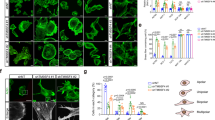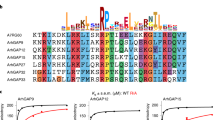Abstract
Current models of tumor cell invasion propose that oncogenic signaling converges upon key orchestrators of cytoskeletal dynamics, including c-Jun N-terminal kinase (Jnk) and RhoGTPase family members; these signals dynamically direct Actin remodeling proteins (ARPs) to catalyze the cytoskeletal changes required for migration. Src is a key driver of tumor aggression, metastasis and patient mortality. To clarify how Src regulates Actin dynamics to promote invasive migration, we performed a genetic modifier screen in a Drosophila model of invasion. Nine genes linked to Actin dynamics were identified that mediate invasion in situ. We found that ARPs were required for many oncogenic effects of Src including Mmp1 expression and initiation of apoptosis. Surprisingly, they were also regulators of Jnk pathway activity: both Src and the small GTPase Rho1 activated Jnk in a manner dependent on ARPs during invasion. Our results suggest that ARPs are not simply downstream executors of signal transduction pathways. Rather, they participate in a positive feedback network involving canonical oncogenic signaling pathways that promote tumor invasion.
This is a preview of subscription content, access via your institution
Access options
Subscribe to this journal
Receive 50 print issues and online access
$259.00 per year
only $5.18 per issue
Buy this article
- Purchase on Springer Link
- Instant access to full article PDF
Prices may be subject to local taxes which are calculated during checkout



Similar content being viewed by others
References
Guarino M . Src signaling in cancer invasion. J Cell Physiol 2010; 223: 14–26.
Le Clainche C, Carlier MF . Regulation of actin assembly associated with protrusion and adhesion in cell migration. Physiol Rev 2008; 88: 489–513.
Olson MF, Sahai E . The actin cytoskeleton in cancer cell motility. Clin Exp Metastasis 2009; 26: 273–287.
Rottner K, Stradal TE . Actin dynamics and turnover in cell motility. Curr Opin Cell Biol 2011; 23: 569–578.
Vidal M, Larson DE, Cagan RL . Csk-deficient boundary cells are eliminated from normal Drosophila epithelia by exclusion, migration, and apoptosis. Dev Cell 2006; 10: 33–44.
Vidal M, Salavaggione L, Ylagan L, Wilkins M, Watson M, Weilbaecher K et al. A role for the epithelial microenvironment at tumor boundaries: evidence from Drosophila and human squamous cell carcinomas. Am J Pathol 2010; 176: 3007–3014.
Godt D, Tepass U . Drosophila oocyte localization is mediated by differential cadherin-based adhesion. Nature 1998; 395: 387–391.
Fox DT, Homem CC, Myster SH, Wang F, Bain EE, Peifer M . Rho1 regulatesDrosophila adherens junctions independently of p120ctn. Development 2005; 132: 4819–4831.
Uhlirova M, Bohmann D . JNK- and Fos-regulated Mmp1 expression cooperates with Ras to induce invasive tumors in Drosophila. EMBO J. 2006; 25: 5294–5304.
Martin-Blanco E, Gampel A, Ring J, Virdee K, Kirov N, Tolkovsky AM, Martinez-Arias A . puckered encodes a phosphatase that mediates a feedback loop regulating JNK activity during dorsal closure in Drosophila. Genes Dev 1998; 4: 557–570.
Vega FM, Ridley AJ . Rho GTPases in cancer cell biology. FEBS Lett 2008; 582: 2093–2101.
Speck O, Hughes SC, Noren NK, Kulikauskas RM, Fehon RG . Moesin functions antagonistically to the Rho pathway to maintain epithelial integrity. Nature 2003; 421: 83–87.
Teramoto H, Crespo P, Coso OA, Igishi T, Xu N, Gutkind JS . The small GTP-binding protein rho activates c-Jun N-terminal kinases/stress-activated protein kinases in human kidney 293T cells. Evidence for a Pak-independent signaling pathway. J Biol Chem 1996; 271: 25731–25734.
Kustermans G, Piette J, Legrand-Poels S . Actin-targeting natural compounds as tools to study the role of actin cytoskeleton in signal transduction. Biochem Pharmacol 2008; 76: 1310–1322.
Goetz JG, Minguet S, Navarro-Lerida I, Lazcano JJ, Samaniego R, Calvo E et al. Biomechanical remodeling of the microenvironment by stromal caveolin-1 favors tumor invasion and metastasis. Cell 2011; 146: 148–163.
Schwartz MA . Integrins and extracellular matrix in mechanotransduction. Cold Spring Harb Perspect Biol 2010; 2: a005066.
Olson EN, Nordheim A . Linking actin dynamics and gene transcription to drive cellular motile functions. Nat Rev Mol Cell Biol 2010; 11: 353–365.
Vartiainen MK, Guettler S, Larijani B, Treisman R . Nuclear actin regulates dynamic subcellular localization and activity of the SRF cofactor MAL. Science 2007; 316: 1749–1752.
Zheng B, Han M, Bernier M, Wen JK . Nuclear actin and actin-binding proteins in the regulation of transcription and gene expression. FEBS J. 2009; 276: 2669–2685.
Szerlong H, Hinata K, Viswanathan R, Erdjument-Bromage H, Tempst P, Cairns BR . The HSA domain binds nuclear actin-related proteins to regulate chromatin-remodeling ATPases. Nat Struct Mol Biol 2008; 15: 469–476.
Bernstein BW, Bamburg JR . ADF/cofilin: a functional node in cell biology. Trends Cell Biol 2010; 20: 187–195.
Cagan RL, Aguirre-Ghiso JA . A local view of cancer. Dev Cell 2012; 22: 472–474.
Leung CT, Brugge JS . Outgrowth of single oncogene-expressing cells from suppressive epithelial environments. Nature 2012; 482: 410–413.
Rudrapatna VA, Bangi E, Cagan RL . Caspase signalling in the absence of apoptosis drives Jnk-dependent invasion. EMBO Rep 2013; 14: 172–177.
Fan Y, Bergmann A . The cleaved caspase-3 antibody is a marker of caspase-9-like DRONC activity in Drosophila. Cell Death Differ 2010; 17: 534–539.
Acknowledgements
We thank members of the Cagan laboratory for important discussions and especially Jay Pendse for statistical assistance and Ruth Johnson for discussions and support regarding actin remodeling. Stocks were obtained from the Bloomington Drosophila Stock Center, Vienna Drosophila RNAi Center and the National Institute of Genetics Fly Stock Center. VAR was supported by 5T32CA078207 and 5T32GM007280. This work was also supported by the National Institutes of Health grants NCI R01 CA109730 and 5R01EY011495.
Author information
Authors and Affiliations
Corresponding author
Ethics declarations
Competing interests
The authors declare no conflict of interest.
Additional information
Supplementary Information accompanies this paper on the Oncogene website
Rights and permissions
About this article
Cite this article
Rudrapatna, V., Bangi, E. & Cagan, R. A Jnk–Rho–Actin remodeling positive feedback network directs Src-driven invasion. Oncogene 33, 2801–2806 (2014). https://doi.org/10.1038/onc.2013.232
Received:
Revised:
Accepted:
Published:
Issue Date:
DOI: https://doi.org/10.1038/onc.2013.232
Keywords
This article is cited by
-
Specificity of the Hox member Deformed is determined by transcription factor levels and binding site affinities
Nature Communications (2022)
-
Yorkie-Cactus (IκBα)-JNK axis promotes tumor growth and progression in Drosophila
Oncogene (2021)
-
MRL proteins cooperate with activated Ras in glia to drive distinct oncogenic outcomes
Oncogene (2017)
-
Rho1–Wnd signaling regulates loss-of-cell polarity-induced cell invasion in Drosophila
Oncogene (2016)
-
Twinstar/cofilin is required for regulation of epithelial integrity and tissue growth in Drosophila
Oncogene (2016)



